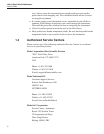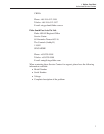
grounding plug for your protection against electrical shock hazards. It
must be plugged directly into a properly grounded three-prong receptacle.
The receptacle must be installed in accordance with local codes and ordi
-
nances. Consult a qualified electrician. DO NOT use an extension cord or
adapter plug.
•
If supplied with user accessible fuses, always replace the fuse with one of
the same rating, voltage, and type.
•
Always replace the power cord with an approved cord of the correct rat
-
ing and type.
•
HIGH VOLTAGE is used in the operation of this equipment. SEVERE
INJURY or DEATH may result if personnel fail to observe safety precau
-
tions. Before working inside the equipment, turn power off and discon
-
nect power cord.
1.3.2
CAUTIONS
•
Always operate this instrument at room temperature between 41°F and
122°F (5°C to 50°C). Allow sufficient air circulation by leaving at least 6
inches (15 cm) of clearance around the instrument.
• Component lifetime can be shortened by continuous high temperature op-
eration.
• DO NOT apply any type of voltage to the display hold terminals. Apply-
ing a voltage to the terminals may cause damage to the controller.
• DO NOT use fluids to clean out the well. Fluids could leak into electron-
ics and damage the instrument.
• Never introduce any foreign material into the probe hole of the insert.
Fluids, etc. can leak into the instrument causing damage.
•
DO NOT change the values of the calibration constants from the factory
set values. The correct setting of these parameters is important to the
safety and proper operation of the calibrator.
•
DO NOT slam the probe sheath in to the well. This type of action can
cause a shock to the sensor and affect the calibration.
•
The instrument and any thermometer probes used with it are sensitive in
-
struments that can be easily damaged. Always handle these devices with
care. DO NOT allow them to be dropped, struck, stressed, or overheated.
•
The Factory Reset Sequence (see Section , Troubleshooting) should be
performed only by authorized personnel if no other action is successful in
correcting a malfunction. You must have a copy of the most recent Report
of Calibration to restore the calibration parameters.
•
DO NOT operate this instrument in an excessively wet, oily, dusty, or
dirty environment. Always keep the well and inserts clean and clear of
foreign material.
•
The dry-well is a precision instrument. Although it has been designed for
optimum durability and trouble free operation, it must be handled with
5
1 Before You Start
Safety Information


















